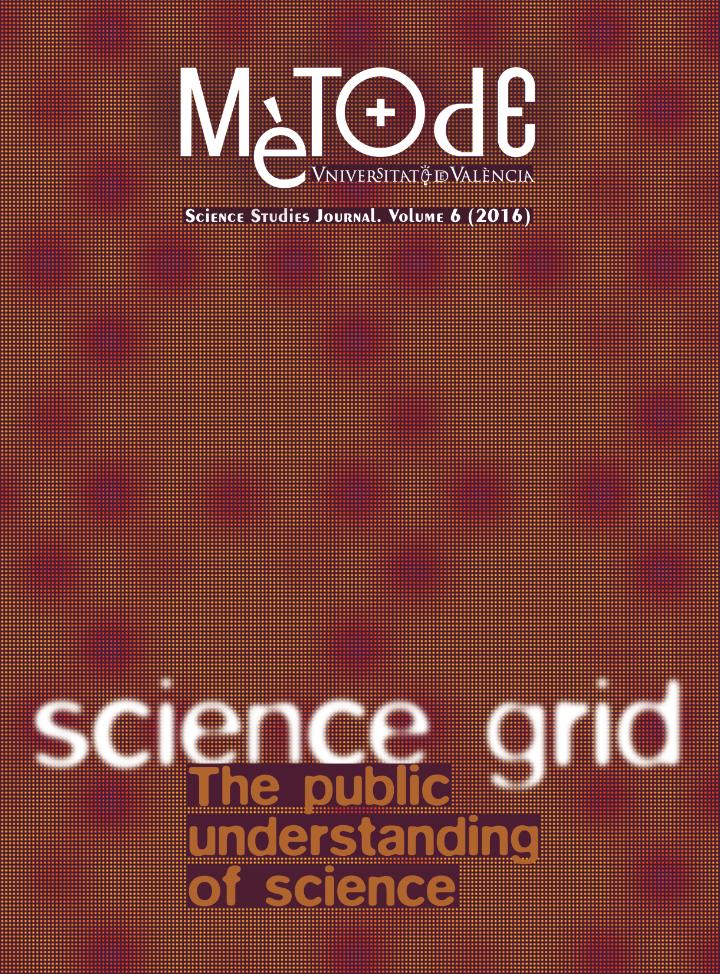Youth, health and social networks: Instagram as a research tool for health communication
DOI:
https://doi.org/10.7203/metode.6.6555Keywords:
youth, emotional distress, methodological innovations, self-management of health, Instagram Abstract
Abstract
Communication is key in the field of health, and the digital age did nothing but increase its importance. Today, the Internet and the new mass media have become basic communication tools, which in the case of young people, are sometimes essential. Most youngsters in the Western world have a latest generation mobile phone, which they use to communicate, access social networks and share their experiences instantly with their friends. Including communication tools such as Instagram in youth health fieldwork poses a number of challenges, but also has the potential for social health research, allowing us to reach young people and enrich research ethnographically.
 Downloads
Downloads
 References
References
Ardévol, E., & Muntañola, N. (Coords.). (2004). Representación y cultura audiovisual en la sociedad contemporánea. Barcelona: Editorial UOC.
Ardévol, E., Roig, A., & Gómez-Cruz, E. (2010). Pràctiques creatives i participació en els nous mèdia. Quaderns del CAC, 34, 27–36.
Barragán, A. (2005). La interrelación de los distintos modelos médicos en la atención del dolor crónico en un grupo de pacientes con neuralgia posherpética. Cuicuilco, 12(33), 61–78.
Best, P., Manktelow, R., & Taylor, B. (2014). Online communication, social media and adolescent wellbeing: A systematic narrative review. Children and Youth Services Review, 41, 27–36. doi: 10.1016/j.childyouth.2014.03.001
Cárdenas, C. (2006). Imágenes de trabajo. Reflexiones hacia una antropología visual aplicada. El caso del proyecto internacional juvenil Barrios del Mundo y su enfoque comunicativo. Revista Chilena de Antropología Visual, 8, 24–46.
Carter, D. (2005). Living in virtual communities: An ethnography of human relationships in cyberspace. Information, Communication & Society, 8, 148–167. doi: 10.1080/13691180500146235
Forbes. (2015, 14 May). Las 5 redes sociales con más crecimiento en 2015. Forbes. Retrieved from http://www.forbes.com.mx/las-5-redes-sociales-con-mas-crecimiento-en-2015
Instagram. (2015, 22 September). Celebrating a community of 400 milion. Instagram. Retrieved from blog.instagram.com/post/129662501137/150922-400million
Ito, M., Okade, D., & Matsuba, M. (2005). Personal, portable, pedestrian: Mobile phones in Japanese life. Cambridge, MA: MIT Press.
Lasén Díaz, A. (2006). Lo social como movilidad: usos y presencia del teléfono móvil. Política y Sociedad, 43(2), 153–167.
Latour, B. (1992). Where are the missing masses? The sociology of a few mundane artifacts. In W. E. Bijker, & J. Law (Eds.), Shaping technology/building society: Studies in sociotechnical change (pp. 225–258). Cambridge, MA: MIT Press.
Lisón Arcal, J. C. (1999). Una propuesta para iniciarse en la antropología visual. Revista de Antropología Social, 1, 5–35.
McIntosh, J. (2010). Mobile phones and Mipoho’s prophecy: The powers and dangers of flying language. American Ethnologist, 37(2), 337–353. doi: 10.1111/j.1548-1425.2010.01259.x
Menéndez, E. (2009). De sujetos, saberes y estructuras. Introducción al enfoque relacional en el estudio de la salud colectiva. Buenos Aires: Lugar Editorial.
Pereira da Silva, S. L., & Pires, M. D. C. F. (2008). Identidades visuales: Vídeo y fotografía en las formas de representación de la identidad de Rio de Janeiro. In E. Ardévol, A. Estalella & D. Domínguez (Coords.), La mediación tecnológica en la práctica etnográfica (pp. 39–147). Sant Sebastià: Ankulegi Antropologia Elkartea.
Pichardo Galán, J. I. (2008). Etnografía y nuevas tecnologías: Reflexiones desde el terreno. In E. Ardévol, A. Estalella, & D. Domínguez (Coords.). La mediación tecnológica en la práctica etnogràfica (pp. 131–149). San Sebastián: Ankulegi Antropologia Elkartea.
Purita, G. (2015). Análisis de las tendencias de uso y participación en las redes sociales a nivel mundial en España. Barcelona: Online Business School. Retrieved from http://recursos.anuncios.com/files/681/25.pdf
Rubio, A. (2010). Jóvenes en red, generación digital y cambio social. In: Ciutadania Jove 2.0. XXVIII Jornades de Polítiques Locals de Joventut. Barcelona. Retrieved from http://www.diba.cat/documents/95670/96986/joventut-fitxers-2010rubio-pdf.pdf
Van House, N., Davis, M., Takhteyev, Y., Ames, M., & Finn, M. (2004). The social uses of personal photography: Methods for projecting future imaging applications. Berkeley School of Information. Retrieved from http:// people.ischool.berkeley.edu/~vanhouse/van%20house_et_al_2004b%20.pdf
Wood, M. A., Bukowski, W. M., & Lis, E. (2015). The digital self: How social media serves as a setting that shapes youth’s emotional experiences. Adolescent Research Review. doi: 10.1007/s40894-015-0014-8
Downloads
Published
How to Cite
-
Abstract1822
-
PDF552
Issue
Section
License
![]()
All the documents in the OJS platform are open access and property of their respective authors.
Authors publishing in the journal agree to the following terms:
- Authors keep the rights and guarantee Metode Science Studies Journal the right to be the first publication of the document, licensed under a Creative Commons Attribution-NonCommercial-NoDerivatives 4.0 International License that allows others to share the work with an acknowledgement of authorship and publication in the journal.
- Authors are allowed and encouraged to spread their work through electronic means using personal or institutional websites (institutional open archives, personal websites or professional and academic networks profiles) once the text has been published.





